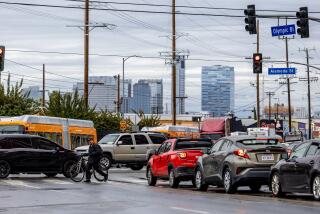Freeway Is Still Standing--Darn, They Say
- Share via
SEATTLE — As this house-proud city took stock of itself on Thursday, residents were pleased to note that their beloved landmarks withstood the 6.8 temblor with strength and grace. The Victorian homes on Queen Anne Hill and the bold steel and glass skyscrapers of downtown all came through.
Then there was the Alaskan Way Viaduct: the aging, double-decker freeway that girds the waterfront, offering a concrete-clad view of Puget Sound. It too was standing. And no one seemed glad.
The elevated section of State Route 99 is the one place that Seattlites agree they would not want to be when an earthquake hits. Common sense told motorists that the busy, 2-mile-long downtown section--built on sawdust-like soil--would pancake in the face of a good jolt.
Well, one arrived, and it didn’t budge.
“There was some wishful thinking. . . ,” admitted Emmett Watson, a longtime columnist for the Seattle Times.
People here are only mildly reluctant to admit that, should the grimy-but-useful freeway have collapsed during the earthquake, little civic hand-wringing would have ensued. The resultant beautification of the city’s tourist mecca--Pike Place Market--would have been one unintended consequence.
Others are willing to say that Mother Nature missed a golden opportunity to spruce up the city.
But the structure’s stubborn refusal to bow down no doubt will launch another in a decades-long call for the demolition of the Alaskan Viaduct, a crusade commonly referred to by the shorthand, “Dump the Duct.”
It seems that the only thing Seattle loves more than talking about itself is complaining about its transportation woes.
In all things, the Alaskan Viaduct plays a crucial role. Built in 1953 to shunt traffic through the city’s then-scruffy waterfront district, the Viaduct now moves nearly 100,000 vehicles a day. It serves to remove pressure from both city streets and the perennially clogged Interstate 5.
But as Seattle revitalized its waterfront in the 1970s and restaurants and apartments sprung up around the area, the plainly ugly freeway began to be seen less as a convenient route home than an urban eyesore.
The roadway was closed Thursday for inspection, but city officials reopened it late in the day. However, Bob Filley of the University of Washington’s College of Architecture and urban planning said that a substantial number of urban planners in Seattle are hoping that the freeway fails to pass structural muster.
“It’s hard to make a case for it,” Filley said. “It’s ugly, it’s noisy, it’s obtrusive, it blocks views, it’s misplaced with our new emphasis on the waterfront. There really isn’t any planner that likes it. Except for transportation planners.”
Some planners here point to what happened after the 1989 Loma Prieta earthquake in the Bay Area. In San Francisco, the elevated Embarcadero Freeway was destroyed and eventually torn down. Its absence allowed the rest of the city to be connected to the waterfront, and afforded an unobstructed view of the bay.
Over the years various plans have been offered to mitigate the Alaskan Viaduct’s dowdiness, most coming short of calling for it to be torn down. One architect proposed converting the upper deck into a tree-lined park and walling in the lower deck for housing and shops. A recent plan suggested hanging ferns from the guardrails.
“So, it’s an ugly freeway . . . with plants on it,” Filley said.
More to Read
Sign up for Essential California
The most important California stories and recommendations in your inbox every morning.
You may occasionally receive promotional content from the Los Angeles Times.














